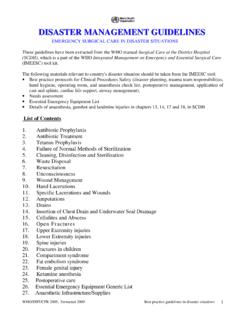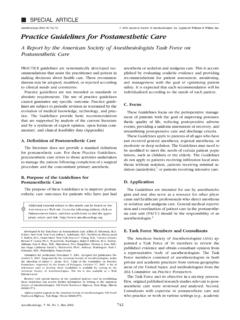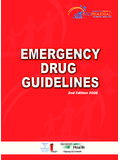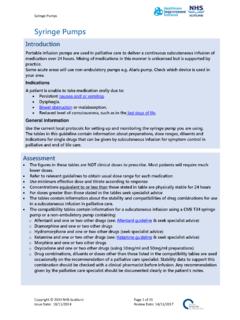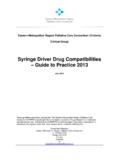Transcription of Guidelines for the Use of Subcutaneous …
1 1 Guidelines for the Use of Subcutaneous Medications in palliative care Dec 2009 Review Dec 2011 2 Acknowledgments These Guidelines have been adapted for local use with kind permission from NHS Greater Glasgow and Clyde. Drug compatibility data has been extracted from the revised (2009) version of the Lanarkshire palliative care Guidelines . 3 Contents Part 1 - Bolus Administration 1. Rationale and Indications 5 2. Advantages and disadvantages of Subcutaneous (SC) route 5 3. S/C cannula insertion sites 6 4. Choice of cannula 7 5. Preparation of patient for insertion of SC cannula 7 6.
2 Removal of cannula 8 7. Information on drugs given SC in palliative care 9 8. Drug Administration Table (drugs commonly given by SC bolus) 10 Part 2 - Continuous Subcutaneous Infusion (CSCI) 1. Rationale and Indications 12 2. Choice of cannula and infusion set 13 3. Potential problems with CSCI 13 4. Frequently asked questions 14 5. Compatibility and stability of drugs 15 6. Commonly used drugs given SC in palliative care 15 7. Single drugs for SC infusion 16 8. Morphine: Drug combinations for SC infusion 19 9. Diamorphine: Drug combinations for SC infusion 21 10.
3 Oxycodone: Drug combinations for SC infusion 23 11. Drug conversions 25 12. Breakthrough analgesia 26 13. References 27 Appendix 1 - Contact details for palliative care Teams 28 Appendix 2 - Contributors 29 4 Part 1 Bolus Administration 51. Rationale and indications When the oral route is unavailable to patients the Subcutaneous (SC) route is the preferred method of drug administration. Intravenous (IV) injections should be avoided because they are invasive and no more effective than the Subcutaneous route. Intramuscular (IM) injections should be avoided, as they are painful, particularly in patients who are cachectic.
4 The SC route should not only be reserved for use in a dying patient. Consider this route for the treatment of pain and/or other symptoms when other routes of administration are inappropriate. Listed below are possible reasons why the SC route could be used: Unable to take by mouth Nausea and vomiting Poor absorption, ileostomy. The SC route will not give better analgesia than the oral route unless there is a problem with absorption or administration. 2. Advantages and disadvantages of SC route Advantages: Can be used when patients can no longer tolerate oral therapy due to nausea, vomiting or dysphagia Increased patient comfort, avoiding the need for repeated injections Suitable for patients who are very drowsy, comatose or semi-comatose Avoids the administration of an excessive number of tablets Cannula can be left in for 72 hours or longer if no redness/inflammation, therefore less demanding on nursing resources.
5 Disadvantages: Possible inflammation or irritation at infusion site Possible leakage of SC site Possible allergic reaction (rare occurrence) 63. SC cannula insertion sites Acceptable SC cannual insertion sites (see diagram): Anterior aspect of the upper arms or anterior abdominal wall Anterior aspect of the thigh The scapula if the patient is distressed and/or agitated Anterior chest wall Sites not suitable for injection Skin folds and breast tissue Directly over a tumour site Lymphoedematous limb or oedema absorption may be reduced The abdominal wall if ascites present Bony prominences little SC tissue, absorption reduced Previously irradiated skin skin may be sclerosed, poor blood supply Sites near a joint uncomfortable, increased risk of displacement Infected.
6 Broken or bruised skin If a local reaction occurs, the cannula should be resited using a fresh cannula and administration set. If this recurs, consider further diluting the drug(s). The site need not be changed for up to 72 hours, or longer if the site is viable (sites may last for 7 days or longer). 74. Choice of cannula The BD Saf-T-Intima cannula, shown below, is the choice of cannula for SC medications. The rationale behind this preference is: Site reactions are less common Insertion is less traumatic Needle stick injury is reduced to patient and staff Less expensive than alternatives Can remain in situ longer than other devices.
7 BD Saf-T-Intima 22 Gauge cannula (blue), code number FSP319. Note The BD Saf-T-Intima cannula has a dead space of Drugs therefore require to be flushed through with at least of appropriate diluent. The diluent used will depend on the medication being given. For guidance please refer to Drug Administration Table, page 12. If a patient is started on a continuous SC infusion they may require a separate BD Saf-T-Intima cannula for bolus medications. It is highly recommended that a luer lock syringe is used for all bolus injections and flushes to avoid possible leakage. 5. Preparation of patient for insertion of SC cannula BD Saf-T-Intima 22 Gauge cannula (blue), code number FSP319 Alcohol impregnated swab Occlusive dressing Non-sterile gloves 8 Procedure 1.
8 Wash hands as per hand hygiene policy. 2. Explain procedure to patient and gain consent. 3. Clean skin with an alcohol-impregnated swab. Allow to dry for a minimum of 30seconds. 4. Put on gloves. 5. Remove and dispose of clamp on the BD Saf-T-Intima to avoid accidental occlusion. 6. Rotate white safety barrel to loosen needle. 7. Remove clear needle cover. 8. Grasp pebbled side wings, pinching firmly. 9. Pinch skin between thumb and forefinger to ensure SC tissue is identified. 10. Insert cannula at a 45-degree angle. 11. Cover the insertion site and wings with a transparent semi-permeable dressing Tegaderm.
9 12. Hold wings of the cannula firmly and remove introducer (needle) by pulling back in a smooth single movement. This should leave injectable bung in-situ. 13. Dispose of needle in sharps container as per local policy. 14. Document date, time and place of cannula insertion in nursing notes. 15. Wash hands as per hand hygiene policy. Notes: Check site 4 hourly (daily in community setting) for erythema, pain or swelling. Document findings of check on monitoring sheet. If insertion is unsuccessful use another cannula. Do not reinsert If blood appears in the cannula insert a new one in another site. If the cannula is being used to deliver a Subcutaneous infusion remove the bung and attach an anti-siphon extension set ( McKinley 100-172S) If the cannula is being used to deliver Subcutaneous bolus injections remove the bung and cap 6.
10 Removal of cannula The SC cannula can remain in situ for up to 72 hours or longer if there is no pain, swelling or erythema at the insertion site. Document removal of cannula in nursing notes Once the cannula is removed cover the site with a small elastoplast if any leakage appears. Note: Before discontinuing SC route and removing cannula, symptoms must be well controlled and patient able to tolerate oral medications. 97. Information on drugs given SC in palliative care It is common in palliative care to use licensed medicines for an unlicensed indication, route or dose. Such use can be supported by experience in clinical practice and accepted reference sources such as The Oxford Textbook of palliative Medicine or the palliative care Formulary.









